Quantifying Forest Structural and Functional Responses to Fire Severity Using Multi-Source Remotely Sensed Data
Abstract
1. Introduction
Burn Indices and Forest Environmental Traits
2. Study Area
3. Research Methods
3.1. Data Acquisition
3.2. Derivation of Structural and Functional Indices
3.2.1. LiDAR-Based Structural Metrics
3.2.2. Thematic Land Cover Classification
3.2.3. Burn Severity Estimation
3.3. Statistical Analysis and Trend Detection
3.3.1. Statistical Analysis
3.3.2. Time-Series Trend Analysis
4. Results and Discussion
4.1. Functional and Structural Trait Assessment by Land Cover Classification
4.2. Relationship Between Functional and Structural Variables and Burn Severity Indices
4.2.1. Local Regression Analysis
4.2.2. Correlation Analysis
4.3. NDVI and NBR Trend Analysis
5. Discussion
6. Conclusions
Author Contributions
Funding
Data Availability Statement
Acknowledgments
Conflicts of Interest
Appendix A
| Path | Row | Acquisition Dates (2019) | Acquisition Dates (2020) | Acquisition Dates (2021) | Acquisition Dates (2022) | Acquisition Dates (2023) | Acquisition Dates (2024) |
|---|---|---|---|---|---|---|---|
| 35 | 38 | 1/28 | 1/31 | 1/1 | 1/4 | 1/7 | 1/10 |
| 3/1 | 2/16 | 1/17 | 1/20 | 2/8 | 1/26 | ||
| 3/17 | 4/4 | 2/18 | 2/5 | 2/24 | 2/11 | ||
| 4/2 | 4/20 | 3/6 | 2/21 | 3/12 | 4/15 | ||
| 4/18 | 5/6 | 3/22 | 3/9 | 3/28 | 5/1 | ||
| 5/4 | 5/22 | 4/7 | 3/25 | 4/29 | 5/17 | ||
| 6/5 | 6/7 | 4/23 | 4/10 | 5/31 | 6/2 | ||
| 6/21 | 6/23 | 5/9 | 4/26 | 7/2 | 6/18 | ||
| 7/7 | 7/9 | 5/25 | 5/12 | 7/18 | 7/20 | ||
| 7/23 | 8/10 | 6/10 | 6/13 | 8/3 | 8/5 | ||
| 8/8 | 8/26 | 6/26 | 7/15 | 9/4 | 8/21 | ||
| 8/24 | 9/27 | 7/12 | 7/31 | 10/6 | 9/6 | ||
| 10/11 | 10/13 | 7/28 | 8/16 | 10/22 | 9/22 | ||
| 10/27 | 10/29 | 8/29 | 9/17 | 11/7 | 10/8 | ||
| 12/14 | 11/14 | 9/14 | 10/3 | 12/9 | 10/24 | ||
| 11/30 | 10/16 | 10/19 | |||||
| 12/16 | 11/1 | 11/4 | 11/9 | ||||
| 12/3 | 11/20 | 12/25 | |||||
| 12/6 | 12/11 | ||||||
| 12/22 | |||||||
| 36 | 37 | 1/3 | 1/6 | 1/8 | 1/27 | 1/30 | 2/18 |
| 1/19 | 2/7 | 2/9 | 2/12 | 2/15 | 3/5 | ||
| 2/20 | 5/13 | 2/25 | 3/16 | 3/3 | 3/21 | ||
| 3/24 | 5/29 | 3/29 | 4/1 | 4/4 | 4/6 | ||
| 4/9 | 6/14 | 4/14 | 4/17 | 4/20 | 4/22 | ||
| 4/25 | 6/30 | 4/30 | 5/19 | 5/6 | 5/8 | ||
| 5/11 | 8/1 | 5/16 | 6/4 | 5/22 | 5/24 | ||
| 5/27 | 8/17 | 6/1 | 6/20 | 6/7 | 7/11 | ||
| 6/28 | 9/2 | 6/17 | 7/6 | 6/23 | 7/27 | ||
| 7/14 | 9/18 | 7/19 | 7/22 | 7/9 | 9/13 | ||
| 8/15 | 10/4 | 8/4 | 8/7 | 7/25 | 9/29 | ||
| 8/31 | 10/20 | 8/20 | 8/23 | 9/27 | 10/15 | ||
| 10/2 | 12/7 | 9/5 | 9/24 | 10/13 | 10/31 | ||
| 10/18 | 12/23 | 9/21 | 10/10 | 10/29 | 12/2 | ||
| 11/3 | 10/7 | 10/26 | 12/18 | ||||
| 11/8 | 11/11 | ||||||
| 12/26 | 11/27 | ||||||
| 36 | 38 | 1/3 | 1/6 | 1/8 | 1/27 | 3/3 | 1/17 |
| 1/19 | 2/7 | 2/9 | 2/12 | 4/4 | 2/18 | ||
| 2/20 | 2/23 | 2/25 | 3/16 | 4/20 | 3/21 | ||
| 3/24 | 5/13 | 4/14 | 4/1 | 5/6 | 4/6 | ||
| 4/9 | 5/29 | 4/30 | 4/17 | 5/22 | 4/22 | ||
| 4/25 | 6/14 | 5/16 | 5/19 | 6/7 | 5/8 | ||
| 5/11 | 6/30 | 6/1 | 6/4 | 6/23 | 5/24 | ||
| 5/27 | 7/16 | 6/17 | 6/20 | 7/9 | 6/9 | ||
| 8/15 | 8/1 | 8/4 | 7/6 | 7/25 | 7/11 | ||
| 8/31 | 8/17 | 8/20 | 8/7 | 9/27 | 7/27 | ||
| 10/2 | 9/2 | 9/5 | 8/23 | 10/13 | 8/12 | ||
| 10/18 | 9/18 | 9/21 | 9/24 | 10/29 | 9/13 | ||
| 12/5 | 10/4 | 10/23 | 10/10 | 9/29 | |||
| 10/20 | 10/26 | 10/15 | |||||
| 11/21 | 11/24 | 11/11 | 10/31 | ||||
| 12/7 | 11/27 | 12/2 | |||||
| 12/13 | 12/18 |
Appendix B. Scatter Plots for All Variables
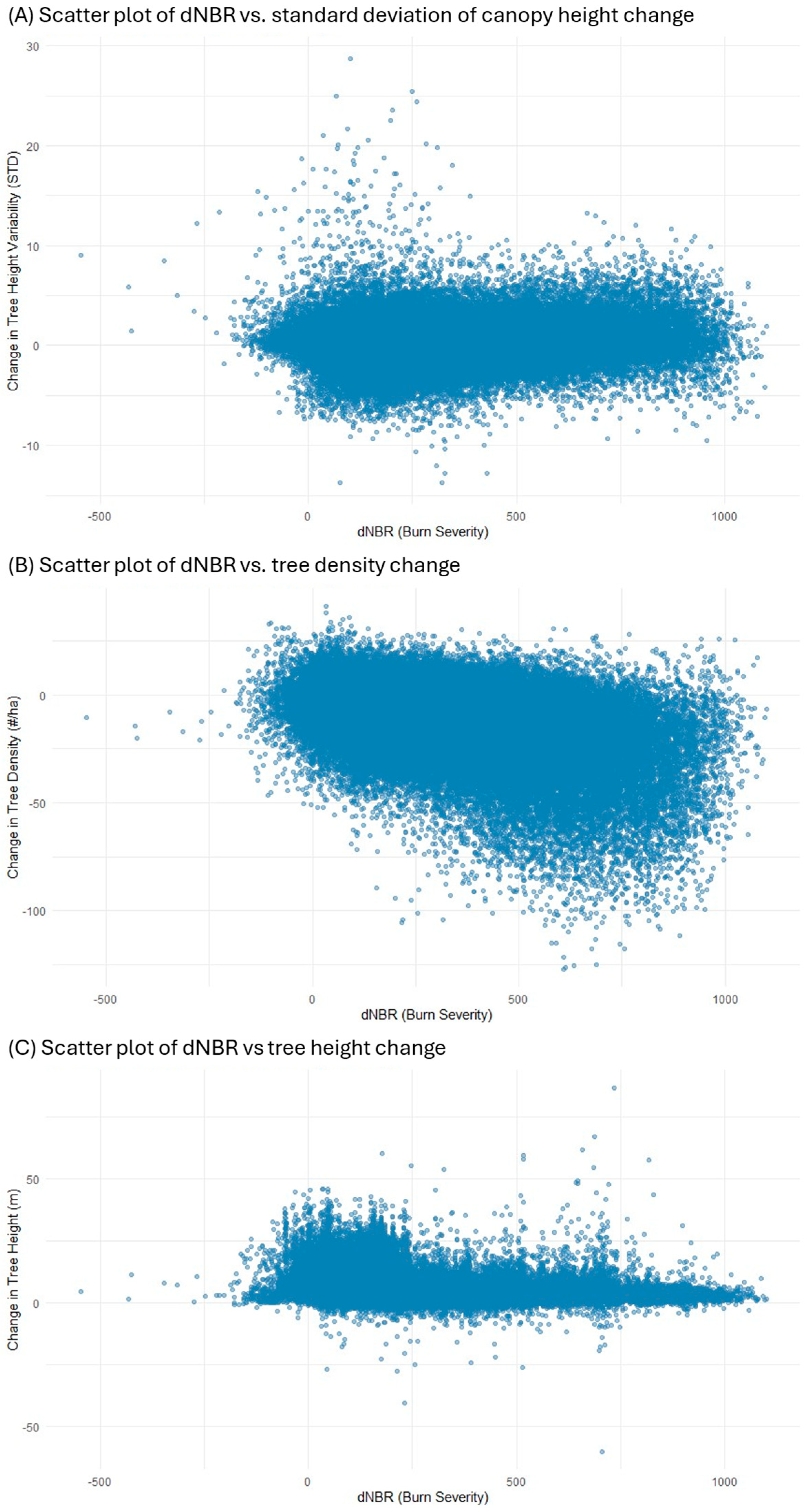
References
- Scott, A.C.; Bowman, D.M.; Bond, W.J.; Pyne, S.J.; Alexander, M.E. Fire on Earth: An Introduction; John Wiley & Sons: Hoboken, NJ, USA, 2013. [Google Scholar]
- Seidl, R.; Turner, M.G. Post-disturbance reorganization of forest ecosystems in a changing world. Proc. Natl. Acad. Sci. USA 2022, 119, e2202190119. [Google Scholar] [CrossRef] [PubMed]
- Shakesby, R.A. Post-wildfire soil erosion in the Mediterranean: Review and future research directions. Earth-Sci. Rev. 2011, 105, 71–100. [Google Scholar] [CrossRef]
- Falk, D.A.; van Mantgem, P.J.; Keeley, J.E.; Gregg, R.M.; Guiterman, C.H.; Tepley, A.J.; Young, D.J.; Marshall, L.A. Mechanisms of forest resilience. For. Ecol. Manag. 2022, 512, 120129. [Google Scholar] [CrossRef]
- Keeley, J.E. Fire intensity, fire severity and burn severity: A brief review and suggested usage. Int. J. Wildland Fire 2009, 18, 116–126. [Google Scholar] [CrossRef]
- Keeley, J.E.; Zedler, P.H. Large, high-intensity fire events in southern California shrublands: Debunking the fine-grain age patch model. Ecol. Appl. 2009, 19, 69–94. [Google Scholar] [CrossRef]
- Keeley, J.E. Fire. In Encyclopedia of Ecology; Jørgensen, S.E., Fath, B.D., Eds.; Academic Press: Oxford, UK, 2008; pp. 1557–1564. [Google Scholar]
- McLauchlan, K.K.; Higuera, P.E.; Miesel, J.; Rogers, B.M.; Schweitzer, J.; Shuman, J.K.; Tepley, A.J.; Varner, J.M.; Veblen, T.T.; Adalsteinsson, S.A. Fire as a fundamental ecological process: Research advances and frontiers. J. Ecol. 2020, 108, 2047–2069. [Google Scholar] [CrossRef]
- Conard, S.G.; Sukhinin, A.I.; Stocks, B.J.; Cahoon, D.R.; Davidenko, E.P.; Ivanova, G.A. Determining Effects of Area Burned and Fire Severity on Carbon Cycling and Emissions in Siberia. Clim. Change 2002, 55, 197–211. [Google Scholar] [CrossRef]
- Hurteau, M.D.; Koch, G.W.; Hungate, B.A. Carbon protection and fire risk reduction: Toward a full accounting of forest carbon offsets. Front. Ecol. Environ. 2008, 6, 493–498. [Google Scholar] [CrossRef]
- Kuenzi, A.M.; Fulé, P.Z.; Sieg, C.H. Effects of fire severity and pre-fire stand treatment on plant community recovery after a large wildfire. For. Ecol. Manag. 2008, 255, 855–865. [Google Scholar] [CrossRef]
- Shive, K.L.; Preisler, H.K.; Welch, K.R.; Safford, H.D.; Butz, R.J.; O’Hara, K.L.; Stephens, S.L. From the stand scale to the landscape scale: Predicting the spatial patterns of forest regeneration after disturbance. Ecol. Appl. 2018, 28, 1626–1639. [Google Scholar] [CrossRef]
- Fernandes, P.M.; Rigolot, E. The fire ecology and management of maritime pine (Pinus pinaster Ait.). For. Ecol. Manag. 2007, 241, 1–13. [Google Scholar] [CrossRef]
- Veraverbeke, S.; Rogers, B.; Randerson, J. Daily burned area and carbon emissions from boreal fires in Alaska. Biogeosciences 2015, 12, 3579–3601. [Google Scholar] [CrossRef]
- Roces-Díaz, J.V.; Santín, C.; Martínez-Vilalta, J.; Doerr, S.H. A global synthesis of fire effects on ecosystem services of forests and woodlands. Front. Ecol. Environ. 2022, 20, 170–178. [Google Scholar] [CrossRef]
- Jones, B.M.; Kolden, C.A.; Jandt, R.; Abatzoglou, J.T.; Urban, F.; Arp, C.D. Fire Behavior, Weather, and Burn Severity of the 2007 Anaktuvuk River Tundra Fire, North Slope, Alaska. Arct. Antarct. Alp. Res. 2009, 41, 309–316. [Google Scholar] [CrossRef]
- Lee, K.; van Leeuwen, W.J.; Gillan, J.K.; Falk, D.A. Examining the Impacts of Pre-Fire Forest Conditions on Burn Severity Using Multiple Remote Sensing Platforms. Remote Sens. 2024, 16, 1803. [Google Scholar] [CrossRef]
- Roy, D.P.; Boschetti, L.; Trigg, S.N. Remote sensing of fire severity: Assessing the performance of the normalized burn ratio. IEEE Geosci. Remote Sens. Lett. 2006, 3, 112–116. [Google Scholar] [CrossRef]
- Cai, L.; Wang, M. Is the RdNBR a better estimator of wildfire burn severity than the dNBR? A discussion and case study in southeast China. Geocarto Int. 2022, 37, 758–772. [Google Scholar] [CrossRef]
- Swetnam, T.L.; Yool, S.R.; Roy, S.; Falk, D.A. On the use of standardized multi-temporal indices for monitoring disturbance and ecosystem moisture stress across multiple earth observation systems in the google earth engine. Remote Sens. 2021, 13, 1448. [Google Scholar] [CrossRef]
- Miller, J.D.; Thode, A.E. Quantifying burn severity in a heterogeneous landscape with a relative version of the delta Normalized Burn Ratio (dNBR). Remote Sens. Environ. 2007, 109, 66–80. [Google Scholar] [CrossRef]
- Bright, B.C.; Hudak, A.T.; Kennedy, R.E.; Braaten, J.D.; Henareh Khalyani, A. Examining post-fire vegetation recovery with Landsat time series analysis in three western North American forest types. Fire Ecol. 2019, 15, 8. [Google Scholar] [CrossRef]
- Allen, J.L.; Sorbel, B. Assessing the differenced Normalized Burn Ratio’s ability to map burn severity in the boreal forest and tundra ecosystems of Alaska’s national parks. Int. J. Wildland Fire 2008, 17, 463–475. [Google Scholar] [CrossRef]
- Eidenshink, J.; Schwind, B.; Brewer, K.; Zhu, Z.-L.; Quayle, B.; Howard, S. A project for monitoring trends in burn severity. Fire Ecol. 2007, 3, 3–21. [Google Scholar] [CrossRef]
- Miller, R.F.; Chambers, J.C.; Pyke, D.A.; Pierson, F.B.; Williams, C.J. A Review of Fire Effects on Vegetation and Soils in the Great Basin Region: Response and Ecological Site Characteristics; Gen. Tech. Rep. RMRS-GTR-308; US Department of Agriculture, Forest Service, Rocky Mountain Research Station: Fort Collins, CO, USA, 2013; 126p. [Google Scholar]
- Schwilk, D.W.; Caprio, A.C. Scaling from leaf traits to fire behaviour: Community composition predicts fire severity in a temperate forest. J. Ecol. 2011, 99, 970–980. [Google Scholar] [CrossRef]
- Han, D.; Di, X.; Yang, G.; Sun, L.; Weng, Y. Quantifying fire severity: A brief review and recommendations for improvement. Ecosyst. Health Sustain. 2021, 7, 1973346. [Google Scholar] [CrossRef]
- Harvey, B.J.; Andrus, R.A.; Anderson, S.C. Incorporating biophysical gradients and uncertainty into burn severity maps in a temperate fire-prone forested region. Ecosphere 2019, 10, e02600. [Google Scholar] [CrossRef]
- Hillman, S.; Hally, B.; Wallace, L.; Turner, D.; Lucieer, A.; Reinke, K.; Jones, S. High-Resolution Estimates of Fire Severity—An Evaluation of UAS Image and LiDAR Mapping Approaches on a Sedgeland Forest Boundary in Tasmania, Australia. Fire 2021, 4, 14. [Google Scholar] [CrossRef]
- Jensen, J.R. Remote Sensing of the Environment: An Earth Resource Perspective 2/e; Pearson Education: Chennai, India, 2009. [Google Scholar]
- Jevšenak, J.; Skudnik, M. A random forest model for basal area increment predictions from national forest inventory data. For. Ecol. Manag. 2021, 479, 118601. [Google Scholar] [CrossRef]
- Kane, V.R.; North, M.P.; Lutz, J.A.; Churchill, D.J.; Roberts, S.L.; Smith, D.F.; McGaughey, R.J.; Kane, J.T.; Brooks, M.L. Assessing fire effects on forest spatial structure using a fusion of Landsat and airborne LiDAR data in Yosemite National Park. Remote Sens. Environ. 2014, 151, 89–101. [Google Scholar] [CrossRef]
- Kane, V.R.; Lutz, J.A.; Roberts, S.L.; Smith, D.F.; McGaughey, R.J.; Povak, N.A.; Brooks, M.L. Landscape-scale effects of fire severity on mixed-conifer and red fir forest structure in Yosemite National Park. For. Ecol. Manag. 2013, 287, 17–31. [Google Scholar] [CrossRef]
- Viana-Soto, A.; García, M.; Aguado, I.; Salas, J. Assessing post-fire forest structure recovery by combining LiDAR data and Landsat time series in Mediterranean pine forests. Int. J. Appl. Earth Obs. Geoinf. 2022, 108, 102754. [Google Scholar] [CrossRef]
- Swetnam, T.W.; Baisan, C.H. Historical Fire Regime Patterns in the Southwestern United States Since AD 1700; United States Department of Agriculture Forest Service General Technical Report Rm: Fort Collins, CO, USA, 1996; pp. 11–32. [Google Scholar]
- Allen, C.D. Fire Effects in Southwestern Forests: Proceedings of the Second La Mesa Fire Symposium; Gen. Tech. Rep. RM-GTR-286; US Department of Agriculture, Rocky Mountain Forest and Range Experiment Station: Fort Collins, CO, USA, 1996; 216p. [Google Scholar]
- Fowler, C.; Konopik, E. The history of fire in the southern United States. Hum. Ecol. Rev. 2007, 165–176. [Google Scholar]
- Roos, C.I.; Guiterman, C.H.; Margolis, E.Q.; Swetnam, T.W.; Laluk, N.C.; Thompson, K.F.; Toya, C.; Farris, C.A.; Fulé, P.Z.; Iniguez, J.M. Indigenous fire management and cross-scale fire-climate relationships in the Southwest United States from 1500 to 1900 CE. Sci. Adv. 2022, 8, eabq3221. [Google Scholar] [CrossRef] [PubMed]
- Savage, M.; Swetnam, T.W. Early 19th-century fire decline following sheep pasturing in a Navajo ponderosa pine forest. Ecology 1990, 71, 2374–2378. [Google Scholar] [CrossRef]
- Covington, W.W.; Moore, M.M. Southwestern ponderosa forest structure: Changes since Euro-American settlement. J. For. 1994, 92, 39–47. [Google Scholar] [CrossRef]
- Hagmann, R.; Hessburg, P.; Prichard, S.; Povak, N.; Brown, P.; Fulé, P.; Keane, R.; Knapp, E.; Lydersen, J.; Metlen, K. Evidence for widespread changes in the structure, composition, and fire regimes of western North American forests. Ecol. Appl. 2021, 31, e02431. [Google Scholar] [CrossRef]
- Liebmann, M.J.; Farella, J.; Roos, C.I.; Stack, A.; Martini, S.; Swetnam, T.W. Native American depopulation, reforestation, and fire regimes in the Southwest United States, 1492-1900 CE. Proc. Natl. Acad. Sci. USA 2016, 113, E696–E704. [Google Scholar] [CrossRef]
- Balch, J.K.; Bradley, B.A.; D’Antonio, C.M.; Gómez-Dans, J. Introduced annual grass increases regional fire activity across the arid western USA (1980–2009). Glob. Change Biol. 2013, 19, 173–183. [Google Scholar] [CrossRef]
- Singleton, M.P.; Thode, A.E.; Meador, A.J.S.; Iniguez, J.M. Increasing trends in high-severity fire in the southwestern USA from 1984 to 2015. For. Ecol. Manag. 2019, 433, 709–719. [Google Scholar] [CrossRef]
- Engine, C. GridMET Drought. 2024. Available online: https://www.drought.gov/ (accessed on 6 March 2024).
- Lynch, M.; Evans, A. 2020 Wildfire Season: An Overview, Southwestern US. Special Report; Ecological Restoration Institute/SouthWest Fire Consortium/Northern Arizona University: Flagstaff, AZ, USA, 2021; p. 18. [Google Scholar]
- Whittaker, R.H.; Niering, W.A. Vegetation of the Santa Catalina Mountains, Arizona. V. Biomass, Production, and Diversity along the Elevation Gradient. Ecology 1975, 56, 771–790. [Google Scholar] [CrossRef]
- Ghasemi Tousi, E.; O’Brien, W.; Doulabian, S.; Shadmehri Toosi, A. Climate changes impact on stormwater infrastructure design in Tucson Arizona. Sustain. Cities Soc. 2021, 72, 103014. [Google Scholar] [CrossRef]
- Fadhel, S.; Rico-Ramirez, M.A.; Han, D. Uncertainty of intensity–duration–frequency (IDF) curves due to varied climate baseline periods. J. Hydrol. 2017, 547, 600–612. [Google Scholar] [CrossRef]
- Whittaker, R.; Buol, S.; Niering, W.; Havens, Y. A soil and vegetation pattern in the Santa Catalina Mountains, Arizona. Soil Sci. 1968, 105, 440–450. [Google Scholar] [CrossRef]
- Brusca, R.C.; Moore, W. A Natural History of the Santa Catalina Mountains, Arizona, with an Introduction to the Madrean Sky Islands; Arizona-Sonora Desert Museum Press: Tucson AZ, USA, 2013. [Google Scholar]
- Whittaker, R.H.; Niering, W.A. Vegetation of the Santa Catalina Mountains, Arizona: A gradient analysis of the south slope. Ecology 1965, 46, 429–452. [Google Scholar] [CrossRef]
- Krausman, P.R.; Cain, J.W., III.; Johnson, H.E. Impact of the Bullock and Aspen Fires on Desert Bighorn Sheep Habitat in the Santa Catalina Mountains, Arizona; Final Report in Fulfillment of Contract, 41-8197; Coronado National Forest, U.S. Forest Service: Tucson, AZ, USA, 2004. [Google Scholar]
- Barton, A.M.; Poulos, H.M.; Koch, G.W.; Kolb, T.E.; Thode, A.E. Detecting patterns of post-fire pine regeneration in a Madrean Sky Island with field surveys and remote sensing. Sci. Total Environ. 2023, 867, 161517. [Google Scholar] [CrossRef] [PubMed]
- Fule, M. Repeated Fire and Extended Drought Influence Forest Resilience in Arizona Sky Islands. Master’s Thesis, College of Agriculture and Life Sciences, University of Arizona, Tucson, AZ, USA, 2023. [Google Scholar]
- Inciweb. 2020. Available online: https://inciweb.wildfire.gov/ (accessed on 26 June 2025).
- Van Leeuwen, W. Monitoring the Effects of Forest Restoration Treatments on Post-Fire Vegetation Recovery with MODIS Multitemporal Data. Sensors 2008, 8, 2017–2042. [Google Scholar] [CrossRef] [PubMed]
- Loveland, T.R.; Irons, J.R. Landsat 8: The plans, the reality, and the legacy. Remote Sens. Environ. 2016, 185, 1–6. [Google Scholar] [CrossRef]
- Roy, D.P.; Huang, H.; Houborg, R.; Martins, V.S. A global analysis of the temporal availability of PlanetScope high spatial resolution multi-spectral imagery. Remote Sens. Environ. 2021, 264, 112586. [Google Scholar] [CrossRef]
- ASPRS. ASPRS positional accuracy standards for digital geospatial data. Photogramm. Eng. Remote Sens. 2015, 81, A1–A26. [Google Scholar] [CrossRef]
- Zhen, Z.; Quackenbush, L.J.; Zhang, L. Trends in automatic individual tree crown detection and delineation—Evolution of LiDAR data. Remote Sens. 2016, 8, 333. [Google Scholar] [CrossRef]
- Roussel, J.-R.; Auty, D.; Coops, N.C.; Tompalski, P.; Goodbody, T.R.; Meador, A.S.; Bourdon, J.-F.; de Boissieu, F.; Achim, A. lidR: An R package for analysis of Airborne Laser Scanning (ALS) data. Remote Sens. Environ. 2020, 251, 112061. [Google Scholar] [CrossRef]
- Harikumar, A.; Bovolo, F.; Bruzzone, L. A local projection-based approach to individual tree detection and 3-D crown delineation in multistoried coniferous forests using high-density airborne LiDAR data. IEEE Trans. Geosci. Remote Sens. 2018, 57, 1168–1182. [Google Scholar] [CrossRef]
- Swetnam, T.L.; Falk, D.A. Application of metabolic scaling theory to reduce error in local maxima tree segmentation from aerial LiDAR. For. Ecol. Manag. 2014, 323, 158–167. [Google Scholar] [CrossRef]
- Tárrega, R.; Calvo, L.; Taboada, A.; Marcos, E.; Marcos, J. Do mature pine plantations resemble deciduous natural forests regarding understory plant diversity and canopy structure in historically modified landscapes? Eur. J. For. Res. 2011, 130, 949–957. [Google Scholar] [CrossRef]
- Dalponte, M.; Bruzzone, L.; Gianelle, D. Fusion of hyperspectral and LIDAR remote sensing data for classification of complex forest areas. IEEE Trans. Geosci. Remote Sens. 2008, 46, 1416–1427. [Google Scholar] [CrossRef]
- Fowler, R.J.; Little, J.J. Automatic extraction of irregular network digital terrain models. In Proceedings of the 6th Annual Conference on Computer Graphics and Interactive Techniques, Chicago, IL, USA, 8–10 August 1979; pp. 199–207. [Google Scholar]
- Zhang, K.; Chen, S.-C.; Whitman, D.; Shyu, M.-L.; Yan, J.; Zhang, C. A progressive morphological filter for removing nonground measurements from airborne LIDAR data. IEEE Trans. Geosci. Remote Sens. 2003, 41, 872–882. [Google Scholar] [CrossRef]
- Lim, K.; Treitz, P.; Wulder, M.; St-Onge, B.; Flood, M. LiDAR remote sensing of forest structure. Prog. Phys. Geogr. 2003, 27, 88–106. [Google Scholar] [CrossRef]
- Miquelajauregui, Y.; Cumming, S.G.; Gauthier, S. Modelling variable fire severity in boreal forests: Effects of fire intensity and stand structure. PLoS ONE 2016, 11, e0150073. [Google Scholar] [CrossRef]
- Quinlan, J.R. Induction of decision trees. Mach. Learn. 1986, 1, 81–106. [Google Scholar] [CrossRef]
- Kuhn, M.; Johnson, K. Applied Predictive Modeling; Springer: New York, NY, USA, 2013; Volume 26. [Google Scholar]
- Pandya, R.; Pandya, J. C5. 0 algorithm to improved decision tree with feature selection and reduced error pruning. Int. J. Comput. Appl. 2015, 117, 18–21. [Google Scholar] [CrossRef]
- Miller, J.D.; Knapp, E.E.; Key, C.H.; Skinner, C.N.; Isbell, C.J.; Creasy, R.M.; Sherlock, J.W. Calibration and validation of the relative differenced Normalized Burn Ratio (RdNBR) to three measures of fire severity in the Sierra Nevada and Klamath Mountains, California, USA. Remote Sens. Environ. 2009, 113, 645–656. [Google Scholar] [CrossRef]
- Miller, J.D.; Quayle, B. Calibration and validation of immediate post-fire satellite-derived data to three severity metrics. Fire Ecol. 2015, 11, 12–30. [Google Scholar] [CrossRef]
- Jacoby, W.G. Loess:: A nonparametric, graphical tool for depicting relationships between variables. Elect. Stud. 2000, 19, 577–613. [Google Scholar] [CrossRef]
- Harrell, F.E., Jr. Ordinal logistic regression. In Regression Modeling Strategies: With Applications to Linear Models, Logistic and Ordinal Regression, and Survival Analysis; Springer: Cham, Switzerland, 2015; pp. 311–325. [Google Scholar]
- Cleveland, W.S. Robust Locally Weighted Regression and Smoothing Scatterplots. J. Am. Stat. Assoc. 1979, 74, 829–836. [Google Scholar] [CrossRef]
- Barbosa, H.A.; Huete, A.; Baethgen, W. A 20-year study of NDVI variability over the Northeast Region of Brazil. J. Arid Environ. 2006, 67, 288–307. [Google Scholar] [CrossRef]
- Hipel, K.W.; McLeod, A.I. Time Series Modelling of WATER Resources and Environmental Systems; Elsevier: Amsterdam, The Netherlands, 1994. [Google Scholar]
- Key, C. Landscape Assessment (LA). In FIREMON: Fire Effects Monitoring and Inventory System; Lutes, D.C., Keane, R.E., Carati, J.F., Key, C.H., Benson, N.C., Gangi, L.J., Eds.; General Technical Report RMRS-GTR-164-CD; USDA Forest Service, Rocky Mountains Research Station: Fort Collins, CO, USA, 2006; p. LA-1–55. [Google Scholar]
- Agee, J.K.; Skinner, C.N. Basic principles of forest fuel reduction treatments. For. Ecol. Manag. 2005, 211, 83–96. [Google Scholar] [CrossRef]
- North, M.; Hurteau, M.; Innes, J. Fire suppression and fuels treatment effects on mixed-conifer carbon stocks and emissions. Ecol. Appl. 2009, 19, 1385–1396. [Google Scholar] [CrossRef]
- Stephens, S.L.; Agee, J.K.; Fule, P.Z.; North, M.P.; Romme, W.H.; Swetnam, T.W.; Turner, M.G. Managing forests and fire in changing climates. Science 2013, 342, 41–42. [Google Scholar] [CrossRef]
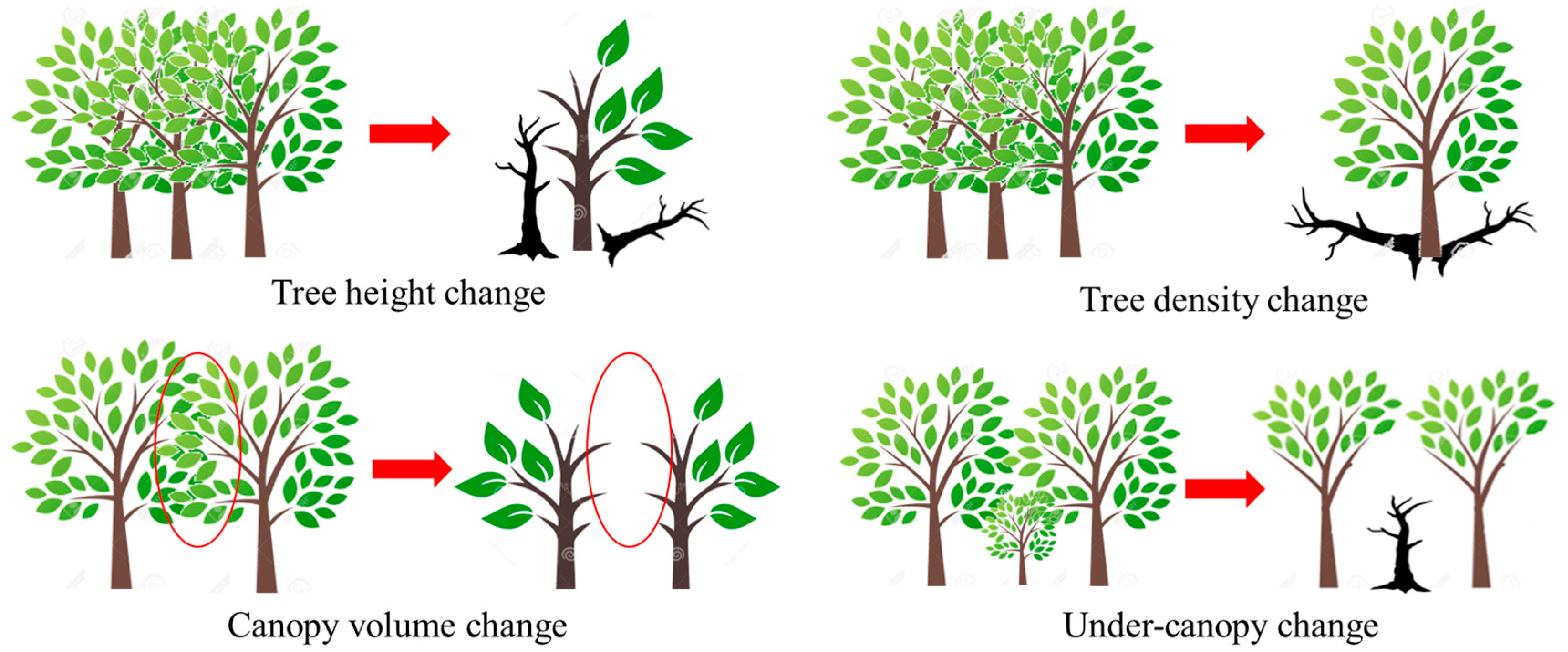
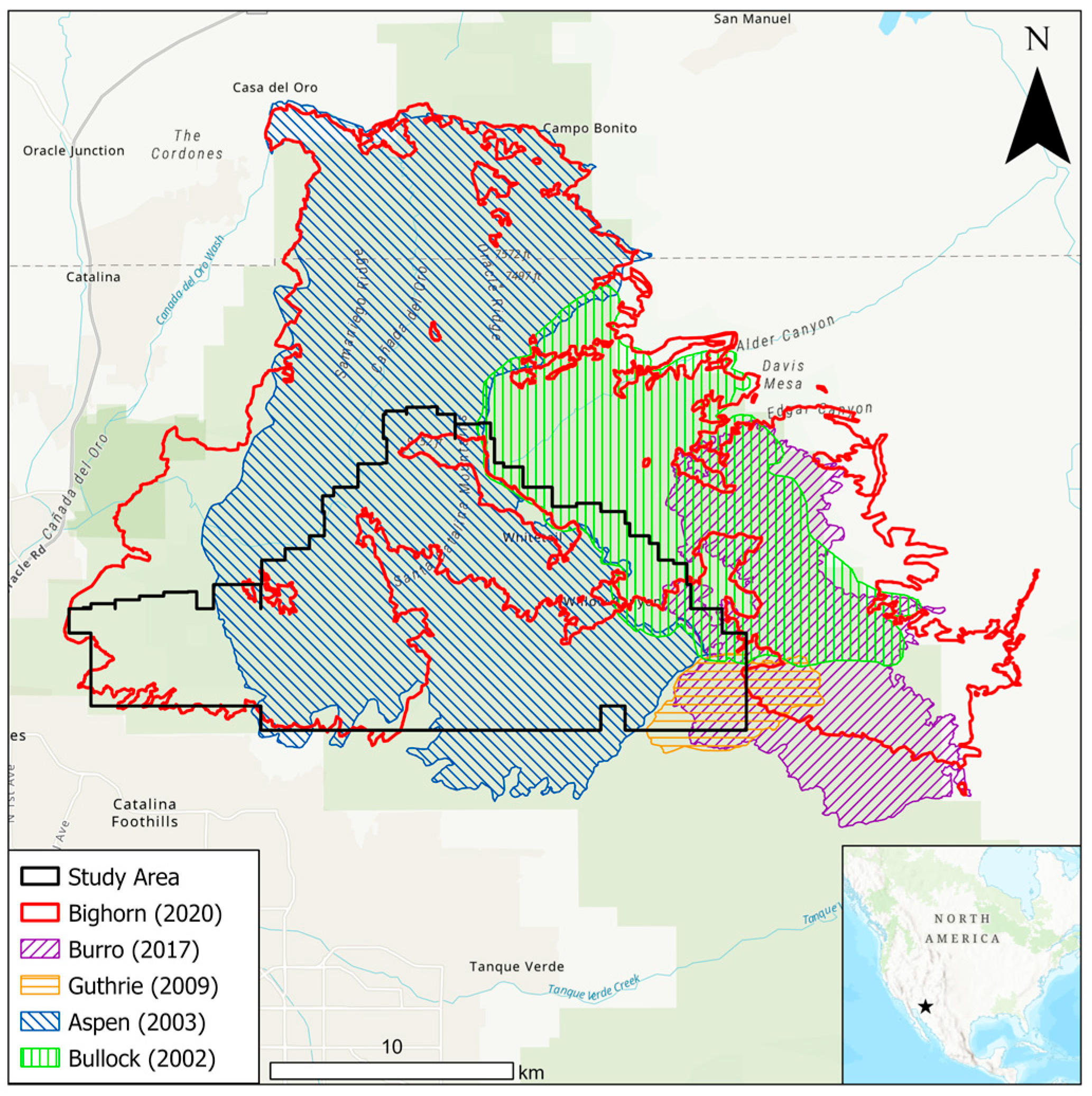
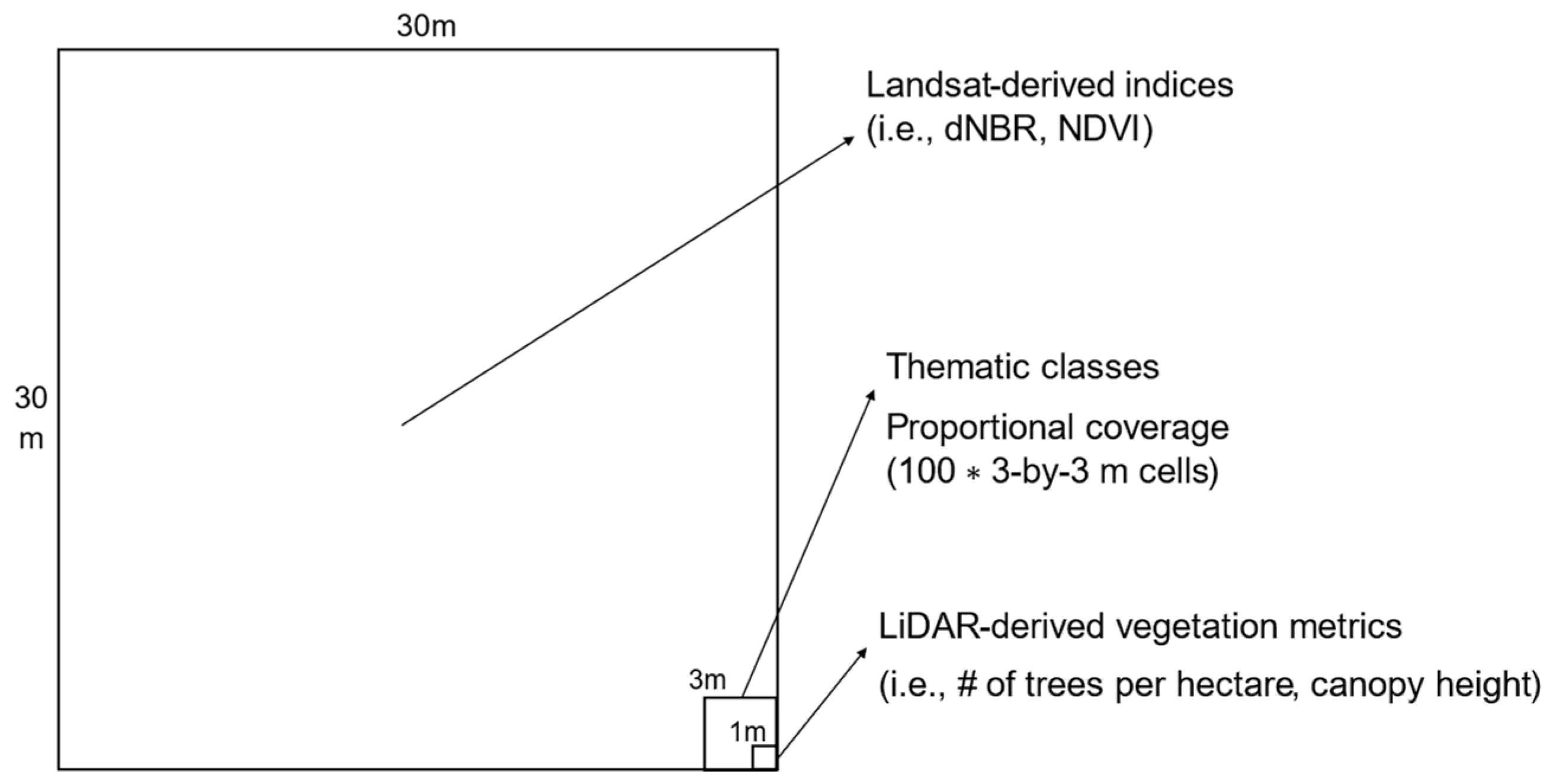
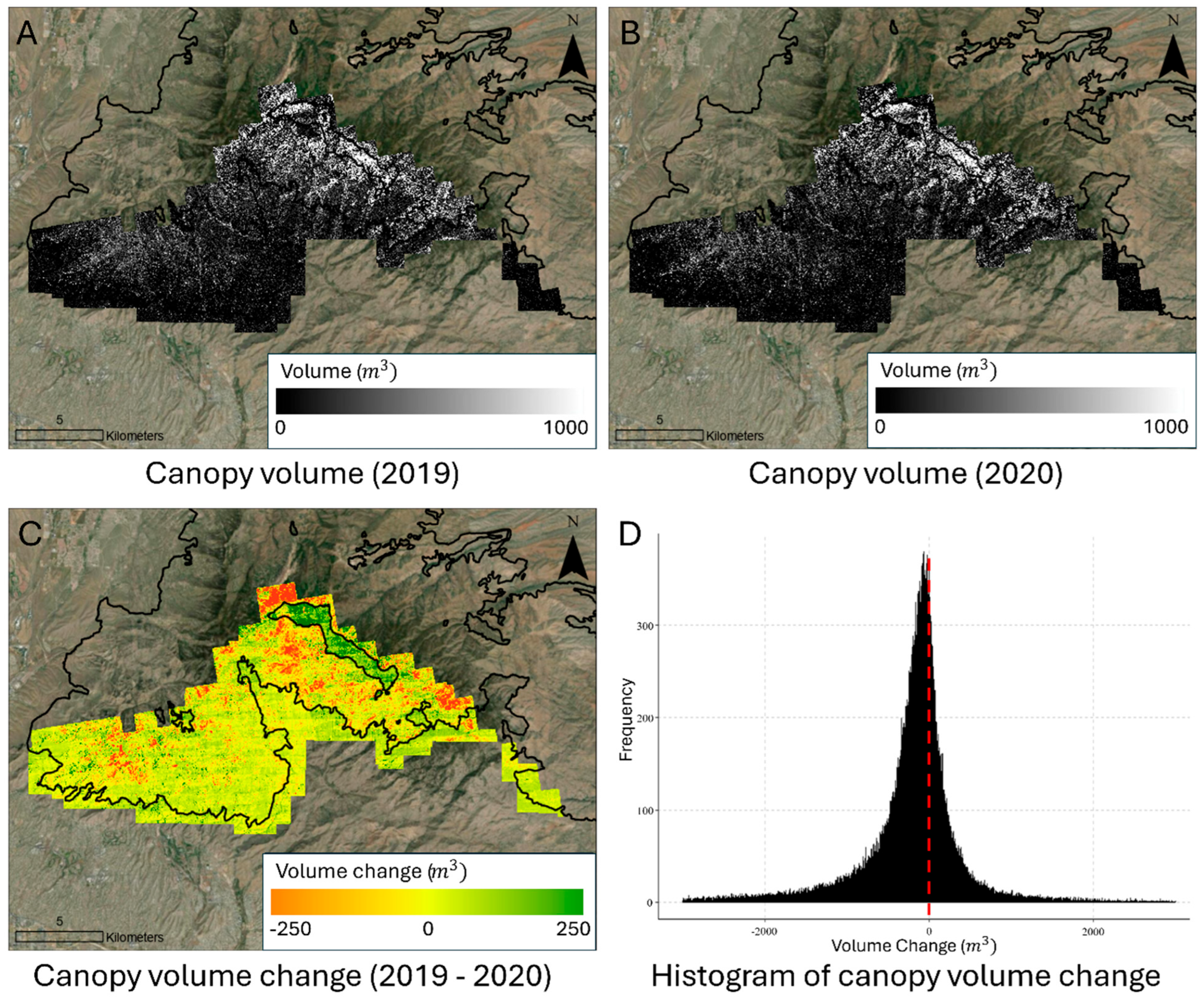
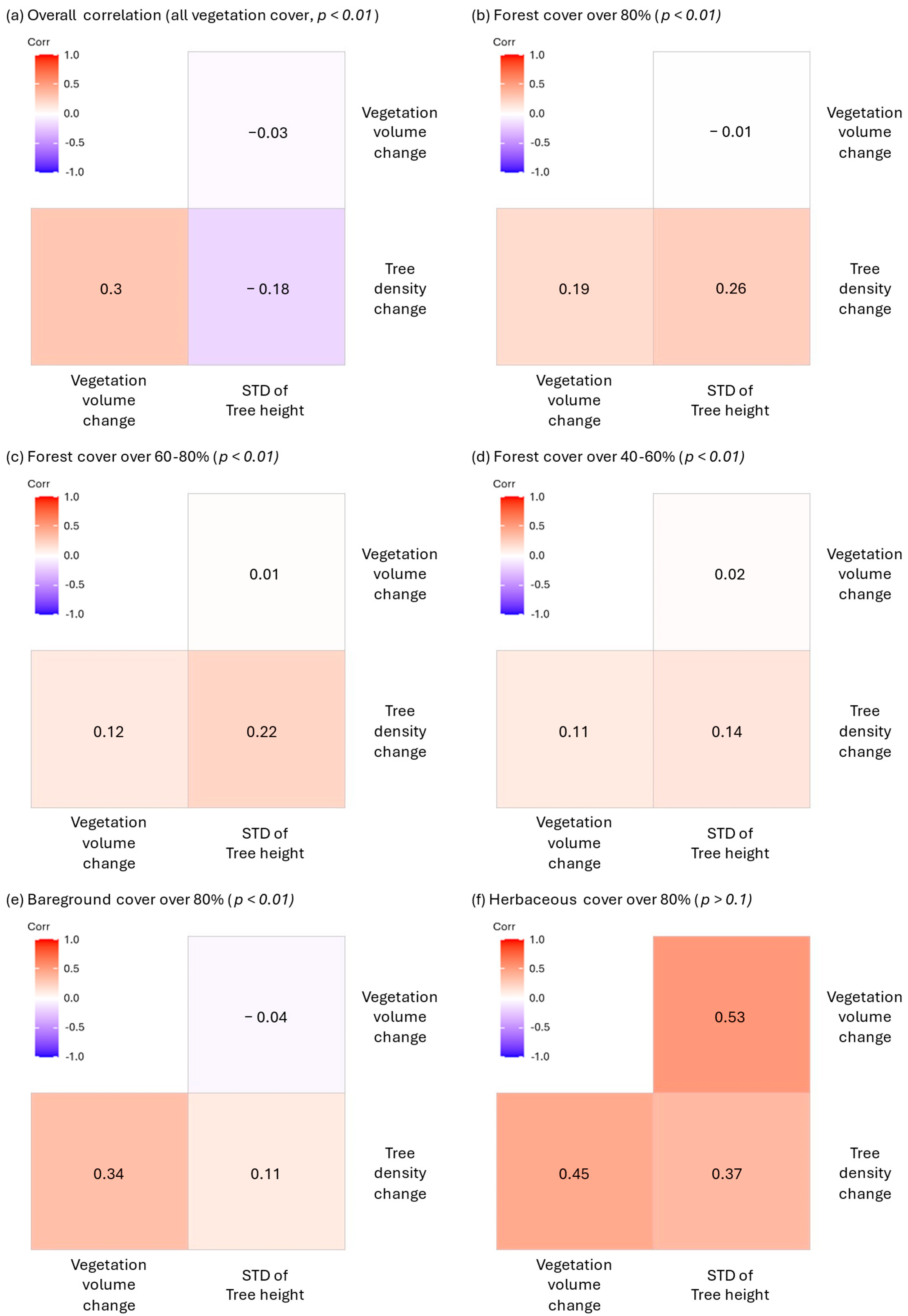
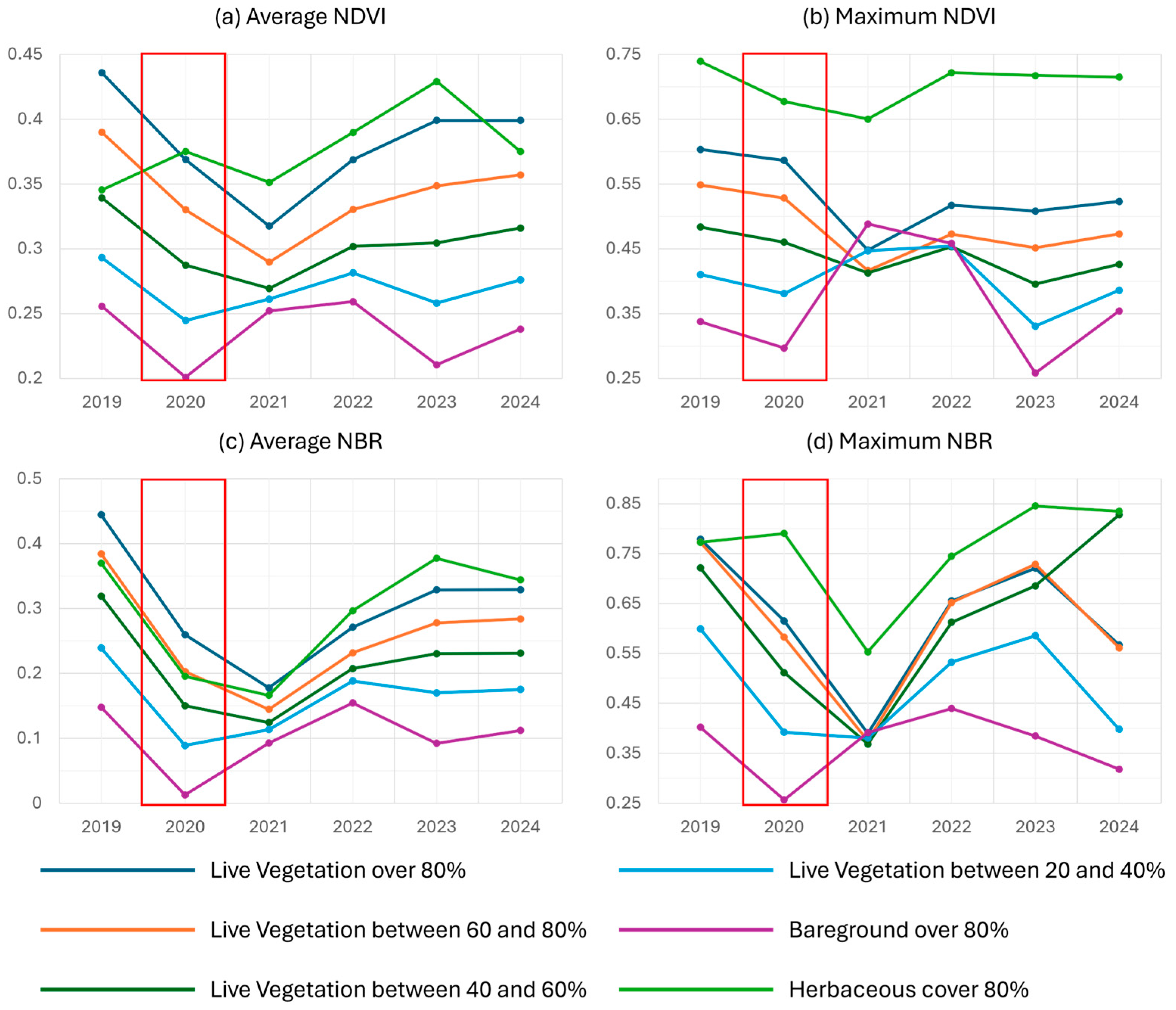
| Thematic Classes | Feature Properties | Surface Area by Coverage (% of Total 12,500 ha) | |
|---|---|---|---|
| Forest Cover | Green vegetation spectral signature present, height > 3 m. | Over 80% | 15% |
| 60–80% | 26% | ||
| 40–60% | 20% | ||
| 20–40% | 15% | ||
| Bare Ground (Rock/Sparse Vegetation) | Weak or no green vegetation spectral signature, low height (<1 m). | Over 80% | 23% |
| Herbaceous | Green vegetation spectral signature, with low height (<3 m). Includes green grass, shrubs, forbs, and ferns. | Over 80% | 1% |
| Landsat-Derived Vegetation Indices | Cover Types (Pre-Fire) | ||||||
|---|---|---|---|---|---|---|---|
| Forest Cover (>80%) | Forest Cover (60–80%) | Forest Cover (40–60%) | Forest Cover (20–40%) | Bare Ground (Over 80%) | Herbaceous (Over 80%) | ||
| NBR | Pre-Fire | 0.17 (0.04) | 0.15 (0.04) | 0.12 (0.04) | 0.09 (0.04) | 0.05 (0.03) | 0.17 (0.02) |
| Post-Fire | 0.06 (0.05) | 0.04 (0.05) | 0.04 (0.04) | 0.03 (0.03) | 0.03 (0.02) | 0.07 (0.04) | |
| dNBR | −0.11 | −0.11 | −0.08 | −0.06 | −0.02 | −0.10 | |
| p-value | <0.000 | <0.000 | <0.000 | <0.000 | <0.000 | <0.000 | |
| NDVI | Pre-Fire | 0.21 (0.04) | 0.19 (0.04) | 0.17 (0.04) | 0.15 (0.03) | 0.13 (0.02) | 0.18 (0.02) |
| Post-Fire | 0.15 (0.03) | 0.14 (0.03) | 0.13 (0.03) | 0.14 (0.03) | 0.14 (0.02) | 0.18 (0.03) | |
| dNDVI | −0.06 | −0.05 | −0.04 | −0.02 | 0.01 | 0 | |
| p-value | <0.000 | <0.000 | <0.000 | <0.000 | <0.000 | 0.43 * | |
| LiDAR-Derived Vegetation Indices | Cover Types (Pre-Fire) | ||||||
|---|---|---|---|---|---|---|---|
| Forest Cover (>80%) | Forest Cover (80 > 60%) | Forest Cover (60 > 40%) | Forest Cover (40 > 20%) | Bare Ground (Over 80%) | Herbaceous (Over 80%) | ||
| Tree Height (m) | Pre-Fire | 11.41 (7.18) | 9.28 (6.77) | 6.79 (5.37) | 4.92 (4.07) | 3.55 (2.93) | 5.49 (6.78) |
| Post-Fire | 4.84 (6.09) | 3.31 (5.16) | 1.93 (3.48) | 1.13 (2.34) | 0.63 (1.58) | 0.23 (0.23) | |
| dHeight | −6.57 | −5.97 | −4.86 | −3.79 | −2.92 | −5.26 | |
| p-value | <0.000 | <0.000 | <0.000 | <0.000 | <0.000 | <0.000 | |
| Tree Density (#/ha) | Pre-Fire | 88.61 (14.97) | 87.69 (14.96) | 81.87 (15.55) | 66.04 (17.73) | 41.82 (19.78) | 46.04 (25.92) |
| Post-Fire | 80.51 (15.75) | 77.18 (16.10) | 70.19 (17.26) | 55.65 (18.57) | 34.03 (18.23) | 29.96 (20.88) | |
| dDensity | −8.10 | −10.51 | −11.68 | −10.39 | −7.79 | −16.08 | |
| p-value | 0.00 | 0.00 | 0.00 | 0.00 | 0.00 | 0.00 | |
| Tree Height (σ) | Pre-Fire | 2.76 (2.10) | 2.84 (2.10) | 3.01 (2.18) | 2.23 (3.16) | 2.21 (1.56) | 3.58 (2.34) |
| Post-Fire | 2.45 (1.87) | 2.56 (1.93) | 2.75 (2.08) | 2.21 (2.96) | 1.88 (1.20) | 3.46 (2.41) | |
| dSTDHeight | −0.31 | −0.28 | −0.26 | −0.03 | −0.33 | −0.12 | |
| p-value | 0.00 | 0.00 | 0.00 | 0.00 | 0.00 | 0.01 * | |
| Group | Dependent Variable | Residual Standard Error | R2 |
|---|---|---|---|
| Forest Cover (>80%) | Tree Density Change | 13.7639 | 0.287 |
| Standard Deviation of Tree Height Change | 1.7948 | 0.060 | |
| Tree Height Change | 4.0425 | 0.089 | |
| Forest Cover (60–80%) | Tree Density Change | 13.6212 | 0.292 |
| Standard Deviation of Tree Height Change | 1.6432 | 0.046 | |
| Tree Height Change | 4.0603 | 0.094 | |
| Forest Cover (40–60%) | Tree Density Change | 13.4388 | 0.254 |
| Standard Deviation of Tree Height Change | 1.4879 | 0.040 | |
| Tree Height Change | 4.3026 | 0.093 | |
| Forest Cover (20–40%) | Tree Density Change | 11.6739 | 0.170 |
| Standard Deviation of Tree Height Change | 1.3633 | 0.041 | |
| Tree Height Change | 4.5592 | 0.097 | |
| Bare Ground (>80%) | Tree Density Change | 10.013 | 0.022 |
| Standard Deviation of Tree Height Change | 1.1577 | 0.007 | |
| Tree Height Change | 5.0447 | 0.075 | |
| Herbaceous (>80%) | Tree Density Change | 13.6517 | 0.210 |
| Standard Deviation of Tree Height Change | 2.5142 | 0.141 | |
| Tree Height Change | 2.2629 | 0.131 |
Disclaimer/Publisher’s Note: The statements, opinions and data contained in all publications are solely those of the individual author(s) and contributor(s) and not of MDPI and/or the editor(s). MDPI and/or the editor(s) disclaim responsibility for any injury to people or property resulting from any ideas, methods, instructions or products referred to in the content. |
© 2025 by the authors. Licensee MDPI, Basel, Switzerland. This article is an open access article distributed under the terms and conditions of the Creative Commons Attribution (CC BY) license (https://creativecommons.org/licenses/by/4.0/).
Share and Cite
Lee, K.; van Leeuwen, W.J.D.; Falk, D.A. Quantifying Forest Structural and Functional Responses to Fire Severity Using Multi-Source Remotely Sensed Data. Geographies 2025, 5, 30. https://doi.org/10.3390/geographies5030030
Lee K, van Leeuwen WJD, Falk DA. Quantifying Forest Structural and Functional Responses to Fire Severity Using Multi-Source Remotely Sensed Data. Geographies. 2025; 5(3):30. https://doi.org/10.3390/geographies5030030
Chicago/Turabian StyleLee, Kangsan, Willem J. D. van Leeuwen, and Donald A. Falk. 2025. "Quantifying Forest Structural and Functional Responses to Fire Severity Using Multi-Source Remotely Sensed Data" Geographies 5, no. 3: 30. https://doi.org/10.3390/geographies5030030
APA StyleLee, K., van Leeuwen, W. J. D., & Falk, D. A. (2025). Quantifying Forest Structural and Functional Responses to Fire Severity Using Multi-Source Remotely Sensed Data. Geographies, 5(3), 30. https://doi.org/10.3390/geographies5030030







